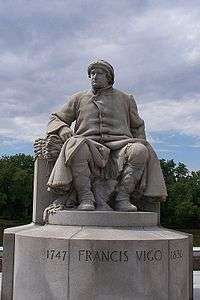Francis Vigo
Francis Vigo born Giuseppe Maria Francesco Vigo (December 13, 1747 – March 22, 1836) was an Italian-American who aided the American forces during the Revolutionary War and helped found a public university in Vincennes, Indiana, USA.
Francis Vigo | |
|---|---|
 Statue by John Angel dedicated to Francis Vigo on the waterfront of George Rogers Clark National Historical Park | |
| Birth name | Giuseppe Maria Francesco Vigo |
| Born | December 13, 1747 Mondovì, Piedmont, Kingdom of Sardinia, present-day Mondovì, Piedmont, Italy |
| Died | March 22, 1836 (aged 88–89) Vincennes, Knox County, Indiana |
| Buried | Greenlawn Cemetery, Vincennes, Knox County, Indiana |
| Allegiance | |
Born in Mondovì, Italy, he served with the Spanish Army in New Orleans. In 1772 he established a fur trading business in St. Louis. In 1783 Vigo moved to Vincennes and operated a fur trading business there.
Early life
American Revolution
Vigo often aided American forces during the Revolutionary War, most famously as an informant to George Rogers Clark. Vigo was sent by Clark to Post Vincennes to inspect and report on the conditions there, but was captured by American Indians and turned over to Lt-Gov Henry Hamilton, who had recaptured Vincennes for the British Crown. Vigo was a Spanish citizen and thus, in 1778, considered a non-combatant, but Hamilton was suspicious of Vigo and held him on parole until the French citizens of Vincennes, led by Father Gibault, demanded that he be released at the threat of cutting off local supplies to Fort Sackville.
Hamilton released Vigo on the condition that he would not "do any thing injurious to the British interests on his way to St. Louis." True to his word, Vigo travelled down the Wabash, Ohio, and Mississippi Rivers to St. Louis before returning to Kaskaskia[1] to inform Col. Clark of the British hold on Vincennes, which prompted Clark to retake the town in 1779.
In addition to his services as a patriot and spy, Vigo was the foremost financier of the American Revolution in the Northwest. When Clark arrived with Continental promissary notes of paper, Vigo exchanged them evenly for hard coin. The American dollar traded poorly among the French citizens, and soon became worthless. Vigo was never repaid during his lifetime, and would recollect that the term douleur to the French signifies grief or pain.[2]
Post-War years
In the 1790s Vigo traded with American merchants on the East Coast of the U.S.
In 1801, Vigo petitioned the U.S. Congress for a donation of land to establish the Jefferson Academy in Vincennes. In 1806, Vigo was named one of the original trustees of the now renamed Vincennes University.
From 1790 to 1810 he was a colonel in the Knox County Militia[3] before resigning, citing age and infirmity.
In 1818 Vigo County, Indiana was established[4] and named for him.
After he was royally feted during a visit to Terre Haute, the Vigo County seat, on July 4, 1834, Vigo revised his will to provide money to purchase a large bell for the Vigo County Courthouse, should he ever be compensated by the United States for services rendered during the Revolution.
As an Italian surname, Vigo's name is pronounced "VEE-goh"; therefore, all streets, buildings, schools, towns, townships, or cities named after him should have their names pronounced "VEE-goh" (not "VY-goh")." [5]
Death
Francis Vigo died March 22, 1836, while living in the home of Jean Baptiste and Elizabeth (Martin) LaPlante, in Vincennes. It was not until 1875, that his estate was allowed payment for $8,016.00, the amount he had used to fund Clark's aborted campaign to take Fort Detroit. This was the only expense the government would officially recognize, but it came with $41,282.60 in interest.[6] As Vigo had no blood-related descendants, however, the government only had to pay for the expenses requested in Vigo's will (which included a bell for the courthouse in Vigo County).
References
- Law, pg 29
- Law, pg 50. Law adds, "The above anecdote I had from the Colonel's own lips."
- "Francis Vigo Papers, 1751-1873, Collection Guide" (PDF). Indiana Historical Society. 2003-06-27. Retrieved 2012-10-23.
- Vigo County :: Home
- http://www.tribstar.com/opinion/ronn-mott-give-francis-vigo-his-due-by-pronouncing-name/article_bff4914c-f22b-5e07-90c1-a21f22b3aacf.html. Retrieved 18 June 2018. Missing or empty
|title=(help) - Somes, 129
- Commager, Henry Steele and Richard B. Morris. The Spirit of Seventy-Six. The story of the American Revolution as told by its participants. Castle Books. HarperCollins Publishers. ©1958. LCCN 67-11325 ISBN 0-7858-1463-9.
- Law, Judge. The Colonial History of Vincennes Harvy, Mason & Co. 1858. ISBN 1-55613-199-2
- Somes, Joseph Henry VandeBurgh. Old Vincennes Graphic Books, New York. 1962. LCCN 62-18417.